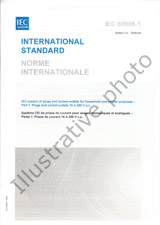We need your consent to use the individual data so that you can see information about your interests, among other things. Click "OK" to give your consent.

IEC 61000-3-12-ed.2.0
Electromagnetic compatibility (EMC) - Part 3-12: Limits - Limits for harmonic currents produced by equipment connected to public low-voltage systems with input current >16 A and <= 75 A per phase
STANDARD published on 12.5.2011
The information about the standard:
Designation standards: IEC 61000-3-12-ed.2.0
Publication date standards: 12.5.2011
SKU: NS-412095
The number of pages: 51
Approximate weight : 153 g (0.34 lbs)
Country: International technical standard
Category: Technical standards IEC
The category - similar standards:
Annotation of standard text IEC 61000-3-12-ed.2.0 :
IEC 61000-3-12:2011 deals with the limitation of harmonic currents injected into the public supply system. The limits given in this International Standard are applicable to electrical and electronic equipment with a rated input current exceeding 16 A and up to and including 75 A per phase, intended to be connected to public low-voltage a.c. distribution systems of the following types: - nominal voltage up to 240 V, single-phase, two or three wires; - nominal voltage up to 690 V, three-phase, three or four wires; - nominal frequency 50 Hz or 60 Hz. Other distribution systems are excluded. The limits given in this edition apply to equipment when connected to 230/400 V, 50 Hz systems. This standard applies to equipment intended to be connected to low-voltage systems interfacing with the public supply at the low-voltage level. It does not apply to equipment intended to be connected only to private low-voltage systems interfacing with the public supply only at the medium- or high-voltage level. This standard defines: a) requirements and emission limits for equipment; b) methods for type tests and simulations. Tests according to this International Standard are type tests of complete pieces of equipment. Conformity with this standard can also be determined by validated simulations. This second edition cancels and replaces the first edition published in 2004 and constitutes a technical revision. The significant technical changes with respect to the previous edition are: - the replacement of the reference fundamental current I1 by the reference current Iref for the calculation of emission limits; - a new added table of current emission limits (Table 5); - a new added annex (Annex A) to define test conditions for some types of equipment; - Deletion of the former Annexes B (Approximate interpolation formulas) and D (Information on the PWHD factor). IEC 61000-3-12:2011 deals with the limitation of harmonic currents injected into the public supply system. The limits given in this International Standard are applicable to electrical and electronic equipment with a rated input current exceeding 16 A and up to and including 75 A per phase, intended to be connected to public low-voltage a.c. distribution systems of the following types: - nominal voltage up to 240 V, single-phase, two or three wires; - nominal voltage up to 690 V, three-phase, three or four wires; - nominal frequency 50 Hz or 60 Hz. Other distribution systems are excluded. The limits given in this edition apply to equipment when connected to 230/400 V, 50 Hz systems. This standard applies to equipment intended to be connected to low-voltage systems interfacing with the public supply at the low-voltage level. It does not apply to equipment intended to be connected only to private low-voltage systems interfacing with the public supply only at the medium- or high-voltage level. This standard defines: a) requirements and emission limits for equipment; b) methods for type tests and simulations. Tests according to this International Standard are type tests of complete pieces of equipment. Conformity with this standard can also be determined by validated simulations. This second edition cancels and replaces the first edition published in 2004 and constitutes a technical revision. The significant technical changes with respect to the previous edition are: - the replacement of the reference fundamental current I1 by the reference current Iref for the calculation of emission limits; - a new added table of current emission limits (Table 5); - a new added annex (Annex A) to define test conditions for some types of equipment; - Deletion of the former Annexes B (Approximate interpolation formulas) and D (Information on the PWHD factor).
These changes apply to this standard:
Amendment 1 - Electromagnetic compatibility (EMC) - Part 3-12: Limits - Limits for harmonic currents produced by equipment connected to public low-voltage systems with input current >16 A and <= 75 A per phase
(Amendement 1 - Compatibilite electromagnetique (CEM) - Partie 3-12: Limites - Limites pour les courants harmoniques produits par les appareils connectes aux reseaux publics basse tension ayant un courant appele > 16 A et <= 75 A par phase)
Change published on 4.6.2021
Selected format:Show all technical information.
Interpretation sheet 1 - Electromagnetic compatibility (EMC) - Part 3-12: Limits - Limits for harmonic currents produced by equipment connected to public low-voltage systems with input current >16 A and <= 75 A per phase
(Feuille d´interpretation 1 - Compatibilite electromagnetique (CEM) - Partie 3-12: Limites - Limites pour les courants harmoniques produits par les appareils connectes aux reseaux publics basse tension ayant un courant appele >16 A et <= 75 A par phase)
Change published on 18.9.2012
Selected format:Show all technical information.
We recommend:
Technical standards updating
Do you want to make sure you use only the valid technical standards?
We can offer you a solution which will provide you a monthly overview concerning the updating of standards which you use.
Would you like to know more? Look at this page.



 Cookies
Cookies
